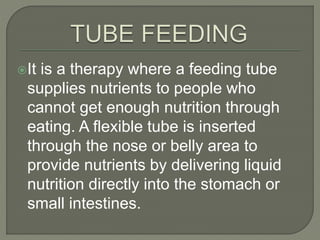
NUTRITION and diet therapy................
- 1. It is a therapy where a feeding tube supplies nutrients to people who cannot get enough nutrition through eating. A flexible tube is inserted through the nose or belly area to provide nutrients by delivering liquid nutrition directly into the stomach or small intestines.
- 2. Providing nutrition Providing fluids Providing medication Decompressing the stomach Removing stomach contents
- 3. It is a way of providing nutrition for patients who are unable to consume an adequate oral intake but have at least a partially functional gastrointestinal (GI) tract that is accessible and safe to use.
- 4. It dependes on the patient’s medical status and the anticipated length of time of tube feeding will be used. There are two types of feeding route: The Transnasal Route and Ostomy
- 5. Transnasal Route - it includes nasogastric (NG), nasoduodenal (ND), and nasojejunal (NJ). - feeding routes that extend from the nose to either the stomach or the small intestine Ostomy - a surgically created opening on the stomach that made to deliver feedings directly into the stomach or intestines
- 6. 1. Gastric tube (GT) offers direct access to the stomach through a surgical cut in the left upper side of your abdomen.
- 7. 2. Gastrojejunal (GJ) tube is a feeding tube that goes into both the stomach and small intestines.
- 8. 3. Jejunostomy tube (J tube), like the G tube, it is placed through an incision in the abdomen but this cut os lower than the G tube.
- 9. 4. Nasogastric Tube (NGT) is inserted into the nose and down through the throat. It is threaded into the esophagus and rests in the stomach.
- 10. 5. Nasojejunal and Nasoduodenal (NJ) and (ND) tubes are similar to NGT but extend past the stomach into the jejunum or duodenum of the small intestine.
- 11. 6. Orogastric Tube (OGT) is similar to NGT but is it inserted into the mouth instead. Itthe follows the same pathway through the throat and esophagus and into the stomach.
- 12. 7. Percutaneous Endoscopic Gastrostomy (PEG) it uses a lighted instrument called an edoscope to place the G tube through a surgical hole in the stomach.
- 13. Comatose patients on mechanical ventilation or with a severe head injury A neuromuscular disorder affecting swallowing reflex Severe anorexia from chemotherapy, HIV, sepsis Upper GI obstruction esophageal stricture or tumor Conditions associated with increased metabolic and nutritional demands include Mental illness like dementia
- 14. Hemodynamic instability with poor end- organ perfusion. Active GI bleeding Small or large bowel obstruction Paralytic ileus secondary to electrolyte abnormalities, peritonitis
- 15. Moderate to severe malabsorption Diverticular disease Fistula in the small bowel Short bowel disease in the early stages.
- 16. Aspiration Diarrhea Nausea Distention and Bloating Dehydration Fluid overload Constipation Gatric rupture Clogged Tube Anxiety Dry mouth
- 17. Daily weight to defect fluid shifts Daily intake and output Gastric residuals every 4-6 hrs in critically ill patients Character and frequency of bowel movements Signs and symptoms of intolerance Daily electrolyte levels, BUN and creatinine External length of the tube, to check for displacement Tube site for infection
- 18. Formula Function Food sources Intact Formula Also called polymeric formulas, contain unaltered molecules of proteins, carbohydrates, and fats. They are best for people who can digest and absorb nutrients without difficulty. Carbohydrates Protein Hydrolyze Also known as Monomeric formulas are "predigested" and are a good choice for patients who lack the ability to digest or have a small absorptive area. Cornstarch, honey, dried fruits and fruit juices Modular It provides different forms of individual nutrients to supplement existing formulas. Dairy, fruits, grains, legumes, and starchy vegetables
- 19. It is an intravenous administration of nutrition, which may include protein, carbohydrate, fat, minerals and electrolytes, vitamins and other trace elements for patients who cannot eat or absorb enough food through tube feeding formula or by mouth to maintain good nutrition status.
- 20. Total parenteral nutrition (TPN): The only source of nutrition is the IV administered nutrition. TPN is given through central venous access. Total parenteral nutrition is not administered through a peripheral intravenous catheter because it has high osmolarity. High osmolarity irritates peripheral veins.
- 21. Peripherical parenteral nutrition (PPN): PPN is used to provide additional nutrition to patients with functional gut and enteral feedings. It is the delivery of nutrients via a peripheral vein (veins located in arms or legs, outside the superior vena cava). The PPN bag may contain insulin to prevent excessively high blood sugars.
- 22. Gastrointestinal surgery Intolerance to enteral nutrition Enterocutaneous fistula Pancreatitis Gastrointestinal obstruction Malabsorption
- 23. •Functioning GI tract •No safe venous access •Hemodynamically unstable •Patient not desiring aggressive support •Anticipated treatment with TPN <5 days in patients without severe malnutrition
- 24. Mechanical and Septic Complications Hyperglycemia Hepatobiliary Disease Biliary Complications Manganese Toxicity Bone Disease Calcium Deficiency Refeeding syndrome Infection Dehydration and Electrolyte Imbalances
- 25. ENTERAL NUTRITION Food getting into the lungs (aspiration) Infection of the tube or insertion site Nausea and vomiting Diarrhea Skin irritation Tube blockage Tube dislodgement
- 26. PARENTERAL NUTRITION Catheter infections Blood clots Liver disease Bone disease Fatigue Memory loss Increased urination